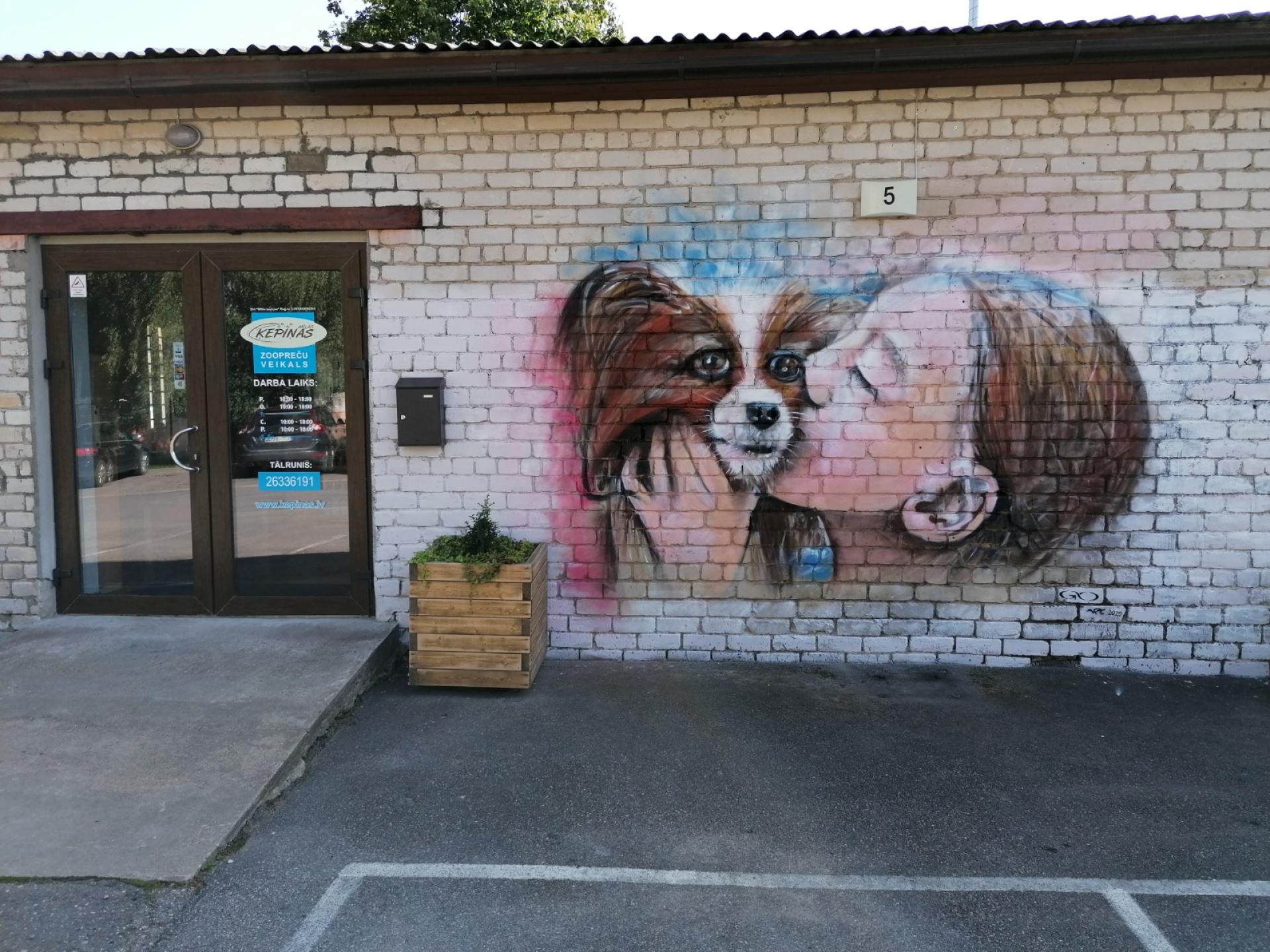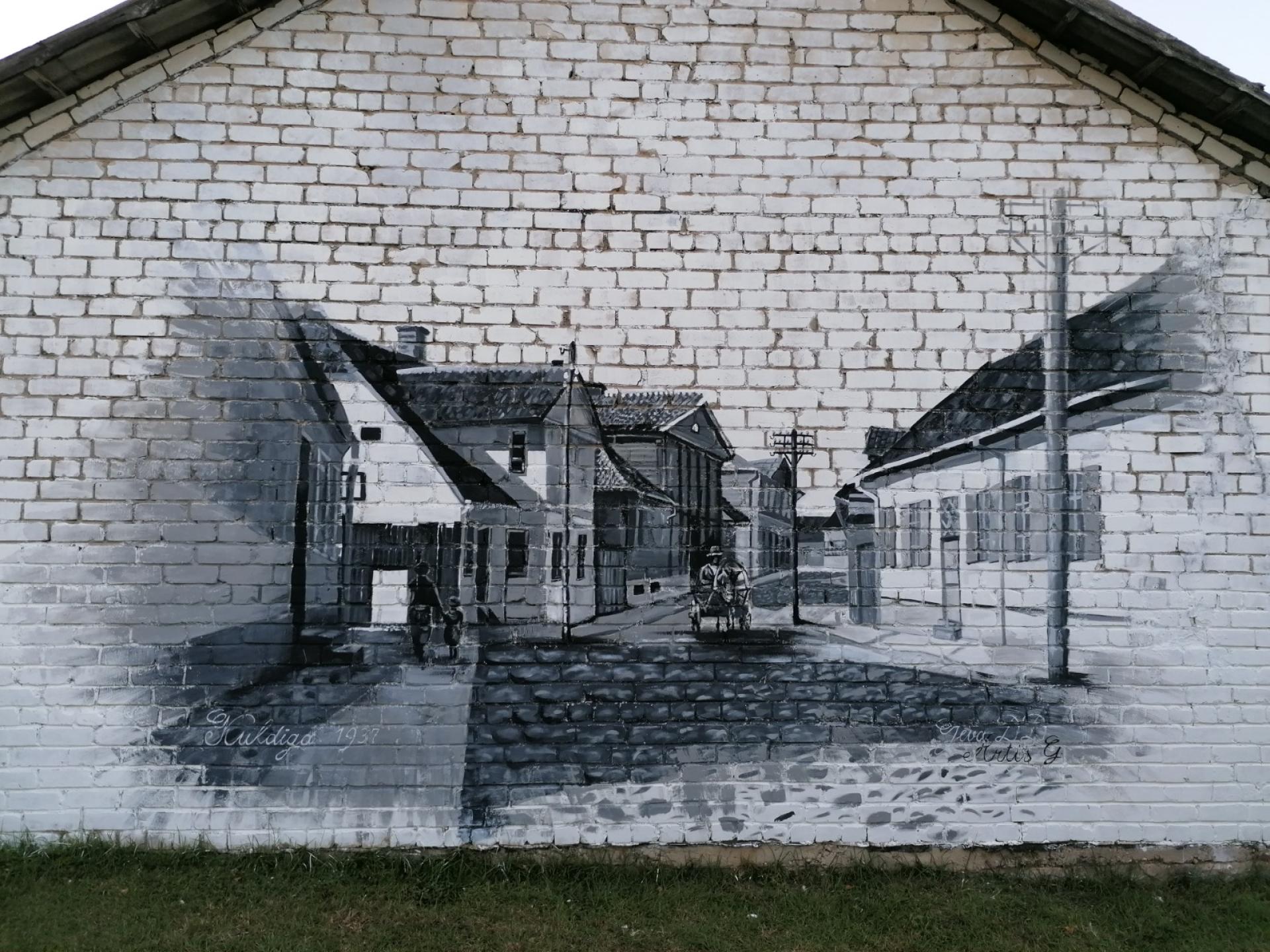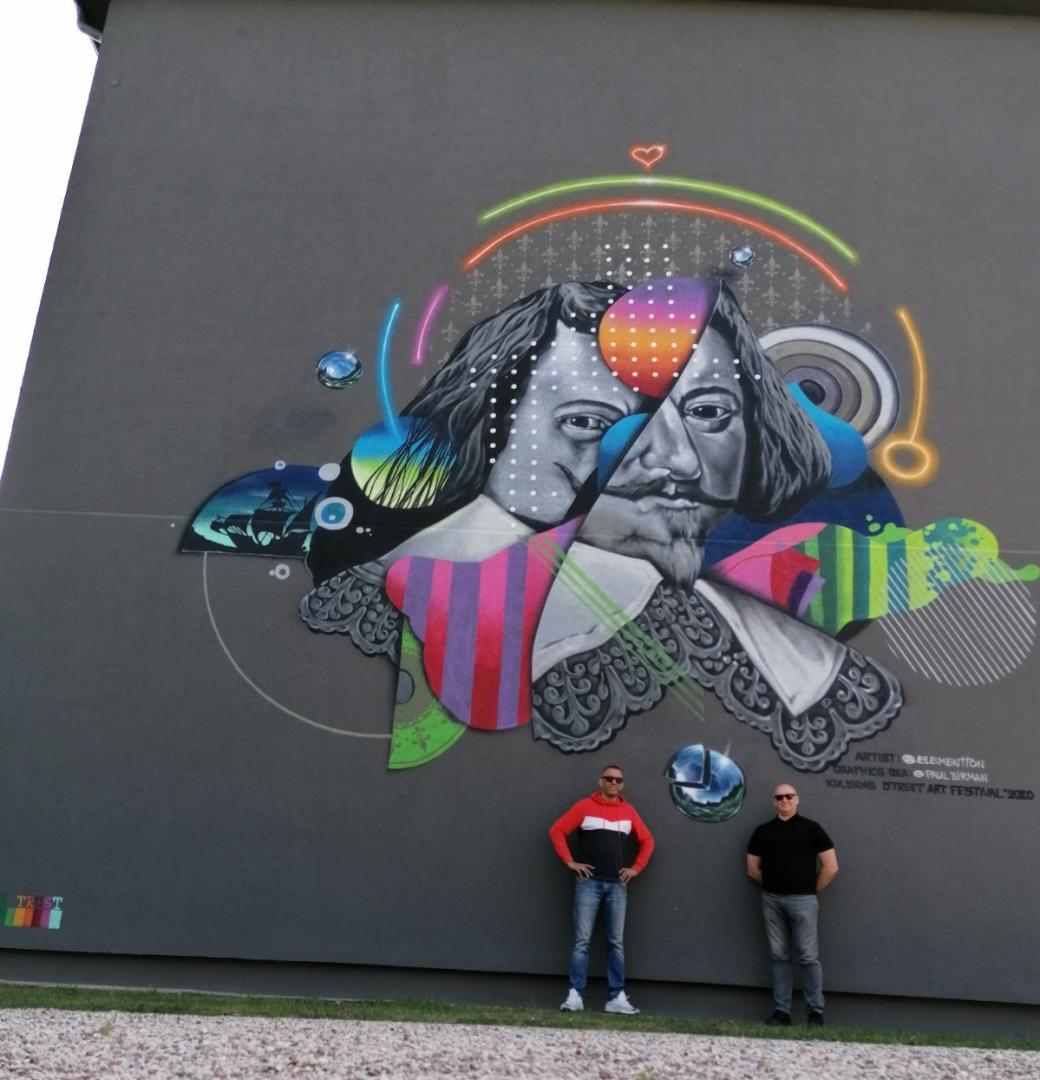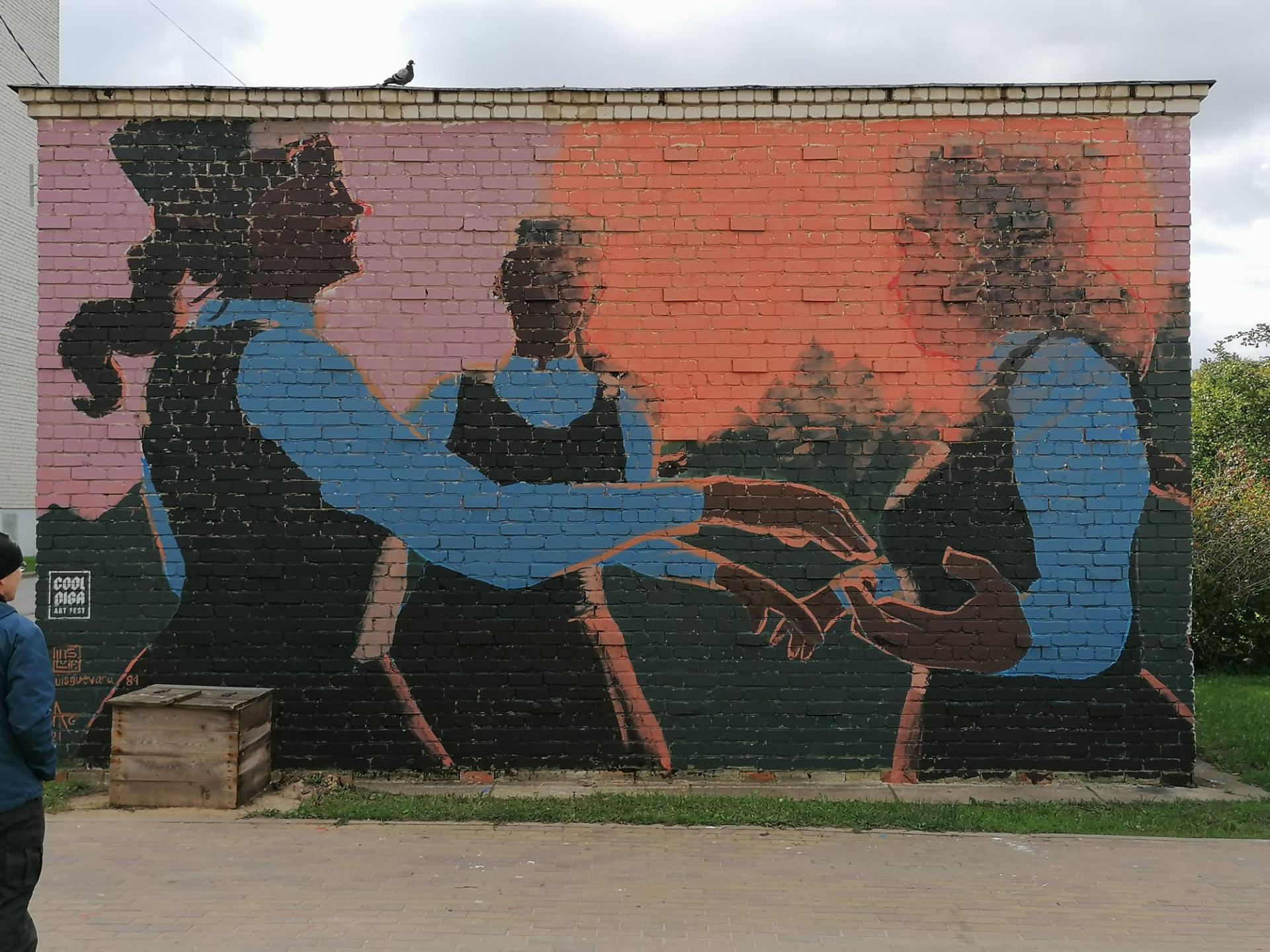Kuldiga Street Art Festival
Basic information
Project Title
Full project title
Category
Project Description
Art is the power able to save the world by translating the communities’ needs. It has not only an extraordinary power to heal, but can also be applied anywhere and by anyone in a quite practical way in order to create sustainable living environment together. And thus the idea of the Kuldiga Street Art Festival was born to create sustainable murals on the buildings of the new part of Kuldiga town (Latvia) gradually transforming the municipality into the Open-Air Art Gallery.
Geographical Scope
Project Region
Urban or rural issues
Physical or other transformations
EU Programme or fund
Which funds
Description of the project
Summary
Kuldiga municipality (Latvia) in cooperation with the NGO Art and Technology Centre has organised “Kuldiga Street Art Festival” for the first time in September 2020. Due to COVID-19 restrictions first time only 8 international artists have participated representing Latvia and Spain. The “Kuldiga Street Art Festival” (the Festival) was a new event in the series of events devoted to art, climate and digital issues implemented in Kuldiga during the last years, e.g. the event "Kuldiga, Europe Thinks Green”. Creating a sense of community and showcasing innovation is key for the Festival. We have also been pioneers in digital data analytics in Latvia regarding the global visitor flow analysis by artificial intelligence in the local climate context. This innovation helped us to identify the number of visitors of the Festival and to predict it in correlation with weather conditions. The Festival aims to bring together all the three key European priorities: climate change, innovation and digitalisation. It is developed as a green interdisciplinary event aiming to meet a growing number of green criteria every year, as by providing this kind of knowledge citizens can contribute to urban development in a sustainable way. It is a gathering both physical and virtual for the entire community to meet, debate, share, learn and celebrate. Likewise, the aim of the event is to transform old and partially abandoned industrial buildings into artworks. At the same time, the Festival is shaped taking into consideration the involvement of local residents by painting the walls of 5-10 houses in Kuldiga with reproductions of Kuldiga's most famous painters. As the Festival will continue to take place, with every year the number of murals will increase by 5-10 and gradually Kuldiga will become as an Open Air Art Gallery, encompassing all the three pillars of the New European Bauhaus initiative – being sustainable, beautiful place made by all together.
Key objectives for sustainability
Sustainability has already become a key issue of our Festival. The objective of the festival is twofold: to make more creative living spaces together with inhabitants and to bring the city closer to nature by using sustainable materials and methods in creation of murals. In order to achieve the sustainable character of the Festival we have established the following main aims:
1. to implement a socially significant, original and innovative art festival that would improve the environment and infrastructure by painting the murals on various buildings in the new part of Kuldiga town at the same time rebalancing the investment of resources in different parts of the town and making it more inclusive;
2. to implement in our Festival the ABC of Sustainability from our previous project partners the Green Film Shooting (Germany);
3. to identify local community groups and NGOs and involve local people in the implementation of their own ideas. The activists involved in the organisation of the Festival continue the cooperation not only annually during the Festival, but also on a regular basis by participating at local, national and international environmental projects, e.g., in creating “The Green Event Handbook of Latvia”;
4. to create new local sustainable long term culture product: the Open Air Art Gallery of Kuldiga;
5. to make our city Kuldiga greener and use sustainably sourced nature-based materials for innovative solutions;
6. to promote our circular, sustainable design and murals as the new normal;
7. to use it as a sustainable festival in order to improve the quality of life of local people;
8. to encourage artists and organisers of the Festival to use bicycles when moving during the festival. Likewise, the organisers of the Festival together with representatives of local inhabitants are taking into consideration several sustainability criteria when choosing the location of murals.
Key objectives for aesthetics and quality
The historical centre of Kuldiga received the European Heritage Label in 2008 and was included in the UNESCO World Heritage Latvian List in 2011. Kuldiga is a town which has preserved its medieval beauty and charm. Cultural heritage is an integral part of our town. We are investing in Aesthetics and Quality, as well as Cultural Diversity and Intercultural Dialogue. We believe, that the art and creative environment in the city plays a huge role in how we feel or behave. Our project is multidisciplinary and teaches children and young artists such values as aesthetics, sustainability, inclusion. Paintings on the walls are more than just drawings or functionality - a more beautiful exterior wall, - but they make the city more aesthetic and these values can influence the everyday life of inhabitants. The project also showcases, how artists have addressed different social challenges by transcending national, cultural, political, social and linguistic borders. Likewise, the project is multicultural and aims at creating an Open Air Art Gallery accessible to any interested person offering the possibility to experience the art, beauty and culture at any time. The accessibility of art was especially important question during the confinement period, when museums and art galleries were closed, but people were longing to enjoy some aesthetic and cultural values. The repurposing of mural spaces of the festival towards positive intergenerational exchanges and community-building is important dimension for aesthetics too.
Key objectives for inclusion
All the interested inhabitants, as well as artists were invited to contribute to the shaping of initiative and developing the Festival into green event, at the same time changing the town into the Open-Air Art Gallery, creating discussion platform and place for generating inspiring ideas and visions for the future development of specific district areas. It was not a measure for a limited number of people, carried out by only a few. We involved inhabitants, young people and children as part of the innovation by creating the cooperation among municipality, academia (Liepaja University) and entrepreneurs (providing paints, meals and accommodation for the artists). In order to involve seniors, it was necessary to ensure access to lifelong learning regardless of the age, gender, educational background, as well as to develop quality and diversity of informal education. A number of local organisations don’t find it easy to reach seniors, and involve them in creative or cultural activities. A successful and desirable form of such participation is an art. Therefore the project provides up-to-date knowledge and skills, new ways to express creativity and contributes to the inclusion into both labor market and society. Likewise, in the framework of the Festival there were organised creative workshops for children and youth on drawing and photography. It was intended to foster cognition, creativity and community inclusion through one of the most accessible technologies and kinds of arts - photography. In addition, it helped to create and develop sustainable international relations, educate and/or improve the skills and competences of those participating in adult education, which is necessary to make creative and innovative decisions, control current challenges and risks, encouraging intercultural interaction and creative citizen self-awareness.
Results in relation to category
With this project we are regaining a sense of community, finding back a feeling of belonging. Our Festival encourage intergenerational solidarity, developing links between education and the arts in local environments, improving our common spaces and places to meet. During the whole Festival all the three elements - culture, art and communities were constantly intertwined, putting at the center the main objective - to improve by creative means the wellbeing and living space of inhabitants. We aimed to improve social cohesion and develop a shared sense of ownership through common activities involving inhabitants. Likewise, we have used the method of storytelling, introducing with the objectives of the Green Deal during the workshops. During the preparation and implementation phase of the Festival we have involved a huge number of people and had the possibility to introduce them with the values set to be at the core of the event. The biggest added value of this project is its sustainability: the large-scale wall paintings will be observable for decades, and with every year the exhibition in the Open-Air Art Gallery will be renewed with approximately 10 new master pieces. It is important to note that this is one of the few festivals, which is a so-called “COVID-friendly” event, because it meets all restrictions, - each artist is making his artwork alone in the open air working with his own mural, but visitors are visiting murals by keeping social distancing. There are several other results of the project to be mentioned: improved knowledge of citizens about the main concepts, solutions and ideas connected to a green, climate-neutral and sustainable city, improved awareness and preparedness of citizens to participate in urban participatory decision-making, improved self-confidence and open-mindedness of the citizens regarding urban participatory decision-making.
How Citizens benefit
Through this project we engage citizens in the transformation of our community. Citizens are learning about the ecological footprint created by such festival and similar events. The Open Air Art Gallery is accessible 24/7 and constantly works as a motivation for socio-cultural motivation, development and improvement of skills related to learning, motivation of creativity, developing artistic style and innovative view on current challenges, as well as broadening the worldview. The organisers of the project are also collecting quantitative and qualitative data regarding the Festival. As to the quantitative data we are collecting numerical information and analysing, e.g. number of visitors, etc. During the Festival of 2020 besides the organisers and artists we have involved about 90 staff members of our municipality, 30 local NGOs from Kuldiga municipality and about 5000 local inhabitants. As to the qualitative data, after the Festival we have organised the survey of local inhabitants asking for their impressions on the implementation of the Festival, the works created, workshops organised and their suggestions as to the next edition of the Festival. The suggestions and comments of the respondents are taken into consideration in organising the next Festival.
Physical or other transformations
Innovative character
As to the innovative character of our Festival we are developing the science-based educational excellence for art professionals, policy makers, and citizens to ensure the implementation of new developments in the design and production of murals as well as innovative techniques. Also the paintings were made in digital way using the pixel art technology. Likewise, in the framework of the Festival we have created the Digital Art Lab to develop real and virtual environments and experiences involving deep digital technologies (AR, AI, Big data) including Digital craft workshops and Digital drone photography journey. These activities were accessible for any kind of age groups, from senior citizens to young Tech Girls too. Participants of the festival were introduced with modern art and technologies, thus fostering their creativity. Digital workshops, modern mural art and contemporary photography is reaching cultural synergy goals. Sometimes people willing to be involved in the cultural community are lacking skills, knowledge, resources and good international practice examples. For us it is important to discuss, how to apply easily accessible technology for their involvement and improve artistic skills making it as a useful tool to become familiar with taste of art in general in combination with the basics of “green city”, cultural heritage, creativity, at the same time sharing eco-friendly attitude, participation at joint activities and spending quality leisure time. The Open Air Art Gallery and its interactive presentation at digital software deals in an innovative way with problems of accessibility, socio-cultural inclusion and adapts to dynamic daily challenges of citizens in appealing, creative and modern way. Through all this our festival is developing innovative murals using bio-composite materials that are recyclable and adapted to address challenging climate conditions.
Learning transferred to other parties
We have concluded that art can translate the needs of communities and public institutions without losing power or integrity. Not only that the creative process has an extraordinary power to heal, but it is an absolute necessity for human and community development. The project results as a concept of art festival is easily replicable best practice example to other local authorities, at the same time also allowing other municipalities to benchmark their environmental performance, assessing progress in comparison with other similar festivals, sharing best practices, experience and tracking improvement over time. The idea of our Festival is already been taken on by several municipalities in the Eastern Partnership countries and our Twinning Towns namely, in Chuguev from Ukraine and Mchet from Georgia. During the last years these municipalities have organised children’s drawing contests in cooperation with Kuldiga municipality. This year the drawing contests will be enlarged with the elements of our Art Festival by drawing murals on the basis of the best drawings submitted. We hope to implement it to our twinning municipalities in Ukraine and Georgia soon, and the drawings will be dedicated to the topics of peace, climate and the environment. The international level of this festival allows sharing best practices and assimilate the specifics of foreign artists’ activities. Most artists work locally and are usually limited to their own country or area, their works are not published or presented more broadly. Internationalism is helping to demonstrate the full potential of the artists based on joint consultation and testing of methods related to the creation of educational exhibitions and their interactive presentations in order to identify the most effective ones in terms of involvement.




